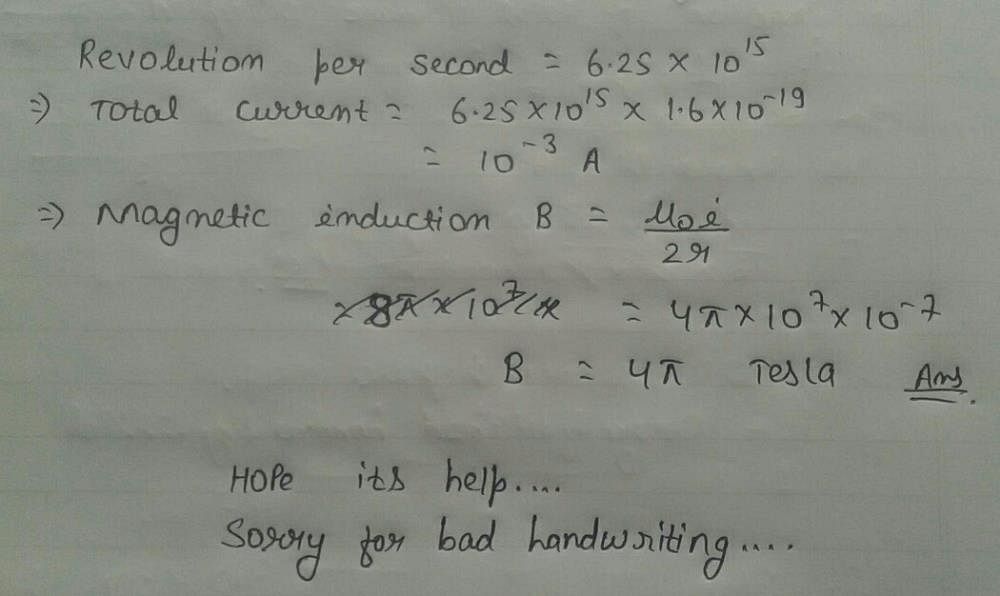Class 12 Exam > Class 12 Questions > In an orbit of radius 0.5 A an electron revol...
Start Learning for Free
In an orbit of radius 0.5 A an electron revolution with frequency of 6.25×10power 15hz.then magnetic induction field at its centre is?
Most Upvoted Answer
In an orbit of radius 0.5 A an electron revolution with frequency of 6...

Community Answer
In an orbit of radius 0.5 A an electron revolution with frequency of 6...
Calculation of Magnetic Induction Field at the Centre of Electron Orbit
Given Information:
- Radius of the electron orbit: 0.5 A
- Frequency of electron revolution: 6.25 x 10^15 Hz
Formulae Used:
- Magnetic Induction Field at the Centre of an Orbit: B = μ₀I/2r
- Current: I = qf
- Charge of Electron: q = 1.6 x 10^-19 C
- Permeability of Free Space: μ₀ = 4π x 10^-7 Tm/A
Calculation:
- Current: I = qf = (1.6 x 10^-19 C) x (6.25 x 10^15 Hz) = 1 x 10^-3 A
- Magnetic Induction Field: B = μ₀I/2r = (4π x 10^-7 Tm/A) x (1 x 10^-3 A) / (2 x 0.5 A) = 1 x 10^-6 T
Answer:
The magnetic induction field at the centre of the electron orbit is 1 x 10^-6 T.
Explanation:
When an electron moves in a circular orbit, it produces a magnetic field due to its motion. The direction of the magnetic field is perpendicular to the plane of the orbit and is given by the right-hand rule. The strength of the magnetic field depends on the frequency of revolution and the radius of the orbit.
In this problem, we are given the radius of the electron orbit and the frequency of revolution. Using the formula for current, we can calculate the current produced by the electron in the orbit. Using the formula for magnetic induction field at the centre of an orbit, we can then calculate the magnetic induction field produced by the electron at the centre of its orbit.
It is important to note that the magnetic field produced by a single electron is very small and is usually measured in microtesla (μT) or even smaller units like nanotesla (nT) or picotesla (pT).

|
Explore Courses for Class 12 exam
|

|
Similar Class 12 Doubts
In an orbit of radius 0.5 A an electron revolution with frequency of 6.25×10power 15hz.then magnetic induction field at its centre is?
Question Description
In an orbit of radius 0.5 A an electron revolution with frequency of 6.25×10power 15hz.then magnetic induction field at its centre is? for Class 12 2024 is part of Class 12 preparation. The Question and answers have been prepared according to the Class 12 exam syllabus. Information about In an orbit of radius 0.5 A an electron revolution with frequency of 6.25×10power 15hz.then magnetic induction field at its centre is? covers all topics & solutions for Class 12 2024 Exam. Find important definitions, questions, meanings, examples, exercises and tests below for In an orbit of radius 0.5 A an electron revolution with frequency of 6.25×10power 15hz.then magnetic induction field at its centre is?.
In an orbit of radius 0.5 A an electron revolution with frequency of 6.25×10power 15hz.then magnetic induction field at its centre is? for Class 12 2024 is part of Class 12 preparation. The Question and answers have been prepared according to the Class 12 exam syllabus. Information about In an orbit of radius 0.5 A an electron revolution with frequency of 6.25×10power 15hz.then magnetic induction field at its centre is? covers all topics & solutions for Class 12 2024 Exam. Find important definitions, questions, meanings, examples, exercises and tests below for In an orbit of radius 0.5 A an electron revolution with frequency of 6.25×10power 15hz.then magnetic induction field at its centre is?.
Solutions for In an orbit of radius 0.5 A an electron revolution with frequency of 6.25×10power 15hz.then magnetic induction field at its centre is? in English & in Hindi are available as part of our courses for Class 12.
Download more important topics, notes, lectures and mock test series for Class 12 Exam by signing up for free.
Here you can find the meaning of In an orbit of radius 0.5 A an electron revolution with frequency of 6.25×10power 15hz.then magnetic induction field at its centre is? defined & explained in the simplest way possible. Besides giving the explanation of
In an orbit of radius 0.5 A an electron revolution with frequency of 6.25×10power 15hz.then magnetic induction field at its centre is?, a detailed solution for In an orbit of radius 0.5 A an electron revolution with frequency of 6.25×10power 15hz.then magnetic induction field at its centre is? has been provided alongside types of In an orbit of radius 0.5 A an electron revolution with frequency of 6.25×10power 15hz.then magnetic induction field at its centre is? theory, EduRev gives you an
ample number of questions to practice In an orbit of radius 0.5 A an electron revolution with frequency of 6.25×10power 15hz.then magnetic induction field at its centre is? tests, examples and also practice Class 12 tests.

|
Explore Courses for Class 12 exam
|

|
Signup for Free!
Signup to see your scores go up within 7 days! Learn & Practice with 1000+ FREE Notes, Videos & Tests.



















